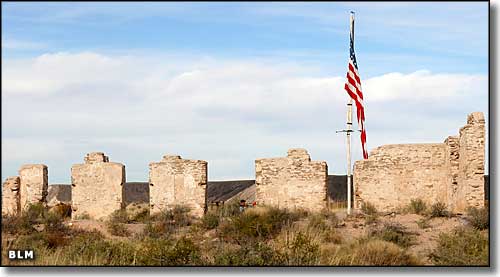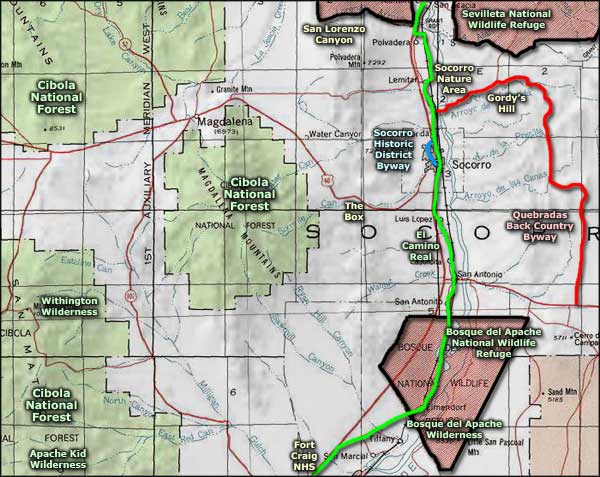
Fort Craig National Historic Site

Fort Craig National Historic Site
First established in 1854, Fort Craig became one of the largest and most important frontier forts in New Mexico. It was one of 8 forts built by the US Army along the old El Camino Real de Tierra Adentro (the Royal Road to the Interior Lands), a 1,200-mile long Spanish colonial trail that connected Santa Fe with El Paso, Chihuahua and Mexico City. Fort Craig played a role in the Civil War and then, after the war, was home to the Buffalo Soldiers of the 9th Cavalry and to the predominantly Hispanic New Mexico Volunteers and New Mexico Militia of the 38th and 125th Infantries. Mentioned prominently with the history of Fort Craig were folks like Rafael Chacon, Kit Carson and Captain Jack Crawford. Troops from Fort Craig were also central to the pursuit and capture of Apache chiefs like Victorio, Geronimo and Nana.
Fort Craig was about 1,050 feet long, east-west, 600 feet wide, north-south, and located on 40 acres atop a bluff near the northern end of the Jornada del Muerto. The fort was named for Captain Louis S. Craig, a popular officer during the Mexican-American War. As large as Fort Craig was, it was very poorly built and the records are full of complaints about the crowded conditions, leaky roofs, muddy floors and crumbling walls and chimneys.
On February 7, 1862, Brigadier General Sibley sent his Confederate Army of New Mexico north from Fort Fillmore intent on making a direct assault on Fort Craig. However, the Union Army at Fort Craig had placed "Quaker guns" (fake wooden cannons) next to empty soldiers hats and in between the real cannons along the massive gravel bastions of the fort. The ruse succeeded in convincing General Sibley to march his troops well around Fort Craig.
On February 21, 1862, thousands of Confederate troops came up against thousands of Union Army troops (many of them New Mexico Volunteers under the command of Colonel Miguel Pino) in the largest Civil War battle fought in the southwestern states. The battle was fought upstream of Fort Craig at Velverde Crossing. The Union forces succeeded in holding the fort and destroying half the Confederate supply wagons.
After the war, the troops stationed at the fort were primarily engaged with controlling Indian raids. By the late 1870's, they had pretty much worked themselves out of a job. The fort was permanently abandoned in 1885. The property was sold at auction to the Valverde Land and Irrigation Company in 1894 and, after several transfers, was finally donated to the Archaeological Conservancy who transferred it to the BLM in 1981.
Today, Fort Craig is the site of Civil War reenactments and the scene for Chautauqua programs: events in which appropriately costumed actors recount events from the time in the participants' own words and language. The Chautauqua experience provides a platform from which we today can get a closer look at the actual experience of the historical persona being reenacted.
Fort Craig National Historic Site is open year round and there are no fees involved.
Maps: BLM - San Mateo Mountains

Fort Craig National Historic Site area map
Sevilleta National Wildlife Refuge - San Lorenzo Canyon Recreation Area
Socorro Nature Area - Gordy's Hill Recreation Area - Quebradas Back Country Byway
The Box Recreation Area - Withington Wilderness - Apache Kid Wilderness
El Camino Real - Socorro Historic District Byway - Cibola National Forest
Photo Galleries - Unique Features - BLM Sites - Outdoor Sports & Recreation
New Mexico's National Forests - Wilderness Areas - New Mexico's National Parks
National Wildlife Refuges - Ski & Snowboard Areas
